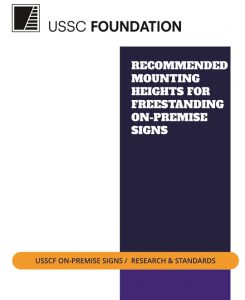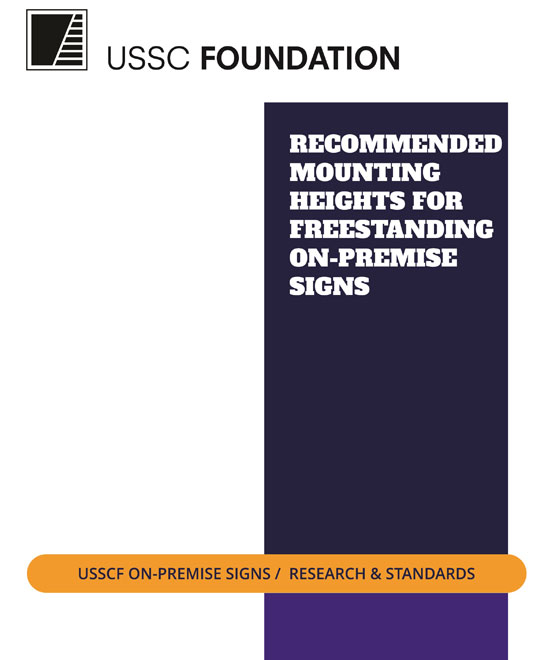 The USSC Foundation announces the completion of a new study on freestanding sign height entitled Recommended Mounting Heights for Freestanding On-Premise Signs, Philip M. Garvey and M. Jennifer Klena, Garvey & Associates (2018). This research was funded by the USSC Foundation and in part by Foundation for the Advancement of the Sign Industry (FASI).
The USSC Foundation announces the completion of a new study on freestanding sign height entitled Recommended Mounting Heights for Freestanding On-Premise Signs, Philip M. Garvey and M. Jennifer Klena, Garvey & Associates (2018). This research was funded by the USSC Foundation and in part by Foundation for the Advancement of the Sign Industry (FASI).
The new Garvey and Klena study presents a different way of looking at freestanding sign height based on science and the needs of the motorist, and a new way of determining the correct height. The publication is currently being formatted for release and printing, and the USSCF anticipates that the full report will be available the first week in January 2019, at the USSC Foundation website and other sources.
Instead of focusing on so-called “maximum sign height”, the new USSCF research answers the more appropriate question: what distance from the ground to the bottom of the sign message is needed in order to make the entire sign message visible and legible for motorists? Garvey and Klena have also developed an app that can be used to easily determine the necessary minimum sign height for any particular location, and details on the app will be available when the report is released.
Virtually every sign code in the United States regulates the height of freestanding sign structures. Sign height is a prime example of the types of acceptable time, place and manner sign regulations that are permitted pursuant under the First Amendment, that the US Supreme Court clearly described as recently as 2015 in the landmark Reed v Gilbert case on signs.
There has been a concern for decades that sign height regulations in many sign codes, in certain zoning districts and for certain users, do not comply with the needs of the motorist and traffic safety. While arbitrary choices have to be made when creating sign regulations, the trend to reduce freestanding signs in certain zoning districts to six feet (6’-0”) or less to the top of the sign, so-called “maximum sign height”, has continued. This has occurred despite the fact that low-mounted signs are often located on busy roadways with multiple lanes of traffic at posted speeds over 30 MPH.
In 2003, the USSC Foundation released its first scientific study on sign height, titled SIGN VISIBILITY, Effects of Traffic Characteristics and Mounting Height, Pennsylvania Transportation Institute, Pennsylvania State University (2003). The 2003 sign height study, or sign “blocking” study, examined the relationship between low-mounted ground signs, traffic safety, and sign visibility. The Penn State study found that the view of messages on low-mounted freestanding signs is blocked by other traffic a high percentage of the time. This lack of sign visibility can directly impact the Motorist and motor vehicle operation.
The most direct and simple solution to the problem presented by low sign mounting restrictions and traffic conditions is to raise the height of the sign. This is a common-sense and reasonable approach to take. If the Sign Height is raised, this issue is avoided. There is no more simple or direct solution to this problem.
Look for the full report release in January 2019.











